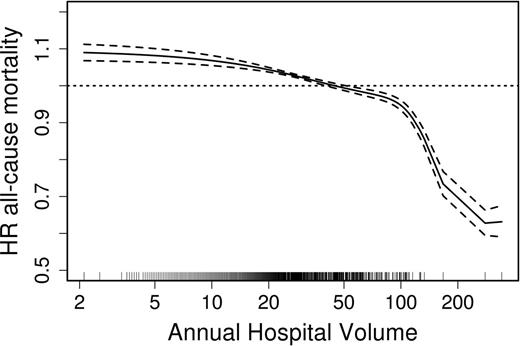Abstract
Background: Non-Hodgkin lymphoma (NHL) is a relatively uncommon cancer with annual incidence of ~70,000 cases but with over 50 distinct subtypes. The goal of this study was to determine the extent to which the number of NHL patients treated annually in a facility (facility volume) affects overall survival (OS). This study used the National Cancer Data Base (NCDB), a nationwide oncology database covering 70% of the US cancer population, to address this question.
Methods: We used the NCDB to identify patients with NHL diagnosed from 1998 to 2006. Year 2006 was used as a cut-off in order to allow a minimum of five years of follow-up for all patients. Only patients treated at facilities with continuous annual reporting to NCDB were included. We classified treatment facilities by quartiles based on facility volume (mean patients/year): Quartile 1 (Q1: 2-13), Quartile 2 (Q2: 14-20), Quartile 3 (Q3: 21-32) and Quartile 4 (Q4: ≥33). We used Pearson correlation methods to examine collinearity, unadjusted Kaplan-Meier methods to estimate OS rates, log rank test to compare survival distributions, and multivariable Cox proportional hazards model to examine the associations between hospital volume and OS adjusting for other covariates of interest. We also included random effects for hospital to more fully adjust for clustering of outcomes within hospitals. To examine non-linear effects of hospital volume, we utilized smoothing splines.
Results: There were 278,985 NHL patients cared for at 1,151 facilities. The distribution of patients according to facility volume was Q1 (10.7%), Q2 (13.5%), Q3 (23.3%) and Q4 (52.5%) and according to facility type was academic (31.2%), comprehensive community (55.9%), community (10.6%) and other (2.3%) centers. The unadjusted median OS by facility volume was: Q1: 61.8 months, Q2: 65.9 months, Q3: 71.4 months and Q4: 83.6 months. After multivariable analysis adjusting for demographic (sex, age, race, ethnicity), socioeconomic (income, insurance type), geographic (area of residence), disease-specific (NHL subtype, stage) and facility-specific (type and location) factors, we show that facility volume remains an independent predictor of all-cause mortality. Compared to patients treated at Q4 facilities, patients treated at lower quartile facilities had a worse OS (Q3HR: 1.05 [95% CI, 1.04-1.06]; Q2HR: 1.08 [1.07-1.10]; Q1HR: 1.14 [1.11-1.17]). We adjusted for hospital as a random effect, performed sensitivity analyses removing primary payor and facility type (due to collinearity with age and facility volume, respectively), and adjusted for Charlson-Deyo co-morbidity score (available only for patients diagnosed after 2003) in secondary models and found similar results. Using smoothing splines, we found a significant non-linear effect of hospital volume on OS (P <0.001). This is depicted in the Figure wherein the hazard ratio of 1.0 corresponded to the average predicted hazard, which occurred at a hospital volume of 59 patients per year.
Conclusions: Patients who were treated for NHL at higher volume facilities had longer OS than those who were treated at facilities with a lower volume. This is the first study in the US using a national sample to show that a volume-outcome relationship exists in the medical management of cancer.
No relevant conflicts of interest to declare.
Author notes
Asterisk with author names denotes non-ASH members.


This feature is available to Subscribers Only
Sign In or Create an Account Close Modal